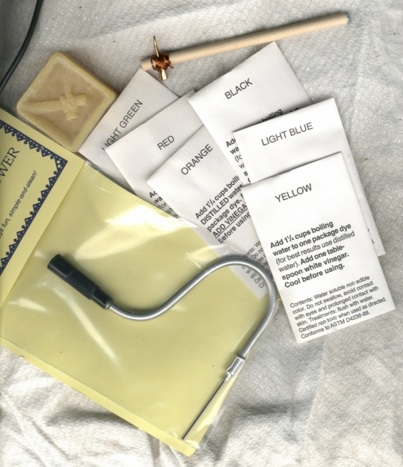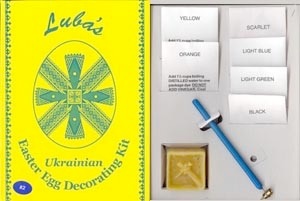Supply Links

I tend to order most of my specialty1 pysanka supplies (except the eggs2) on line nowadays. Delivery is quick and relatively cheap, and few stores, even Ukrainian ones, stock an extensive selection of pysankarstvo supplies in the off-season. The nearest such shop selling pysanka supplies is a good 45 minute drive (good weather, no traffic) for me, so buying in person doesn’t really save me any money, and it’s not a particularly green activity.
Mind you, I believe in supporting stores that carry these supplies, and stop in and shop whenever I’m in the neighborhood. I make an annual trip to the Polish Art center just to see what interesting books Joan has found in the past year–not all of them make it to her web site.
If you’re lucky enough to have a shop that stocks pysanka supplies in your area, do try to patronize it (if the prices–and drive–are reasonable). There are shops in many cities that carry pysanka supplies; Ann Morash is compiling a list of them here. Check to see if you have one in your neighborhood, and also check to see if your neighborhood shop is listed.
CAVEATS: Before buying anything on line or through a catalogue, make sure you comparison shop. While prices on most items are fairly consistent among sellers, there are resellers who really jack up prices, sometimes to 2-3 times what others charge. Others may offer reasonable prices, and then sock you with high shipping charges.
Always check several sites to make sure the price and/or shipping charges you are quoted are reasonable. If you are buying only one or two small items, (e.g. a piece of wax or a few packets of dye), the standard shipping charges may be more than the items you are buying. In that case, you may wish to contact the seller directly (e-mail or phone) about charging you actual shipping rather than standard. Some sellers will automatically give you better prices on these sorts of items; others won’t.
GENERAL SUPPLIES
For general supplies, particularly bulk purchases for classes, I usually buy from the Ukrainian Gift Shop (UGS, Minneapolis MN). They have just about everything a pysankarka could want, from dyes to wax to styluses to templates to findings. Their on-line catalog is well organized and ordering is easy, and they give discounts on bulk orders to pysanka teachers (you have to call and ask, though). Elko Perchyshyn has quite generously helped me out several times when I’ve needed pysanka supplies to bring to Ukraine or India for charity workshops there.
I do enjoy browsing, though, and thus stop into the Polish Art Center whenever I’m in the neighborhood (Hamtramck, MI). Joan carries all of the UGS supplies, and at about the same price (unlike many resellers, who jack up the prices significantly), as well as the Wax Art Supply line. She also has a huge selection of Polish and (some) Ukrainian books, and lots of books on pysanky. And, of course, there is the pottery and the Eastern European sweets.......
Wax Art Supply used to be mostly a wholesaler of electric styluses but, under the guidance of the original owner’s daughters, has expanded to carry a full line of pysanka supplies, mostly of their own manufacture. While they do not (yet) carry books, they do sell just about everything else you need to make pysanky, including some very nice dark strip wax.
Ukrainian EggCessories in Canada is also a full service online store that sells just about everything you need to write pysanky. They have their own line of Canadian themed dyes, as well as their own design of candle-heated and electric kistky. EggcCessories also offers beeswax, pysanka stands, egg top findings and kistka stands. And the offer teacher and wholesale discounts on the supplies and tools that they manufacture themselves–call for discounts.
All Things Ukrainian has expanded its offerings of pysanka supplies, and now carries a full line at competitive prices, as well as selling imported Ukrainian crafts and pysanky. Their site is worth a look.
To help you find a supplier/shop in your area, go to Ann Morash’s site and this page. And if you have a favorite shop that is not listed, contact her and let her know.
Links:
PYSANKA KITS
A kit can be a very good deal for a beginner, as the kit usually costs significantly less than buying the supplies individually. I myself am partial to Luba’s kits, which are sold by the Ukrainian Gift Shop––and my friends marvel at how I got my name onto the kit! I prefer the kits with delrin styluses and a nice selection of dyes (6 is a good number). The kit comes with some design sheets and basic instructions.
Many pysanka retailers sell the UGS kits, and, at Easter time, they sometimes show up in craft stores like Michael’s or in catalogues of children’s toys. Keep in mind, though, that resellers can jack up prices on the kits, especially around Easter. Check the prices at the UGS shop for a baseline.
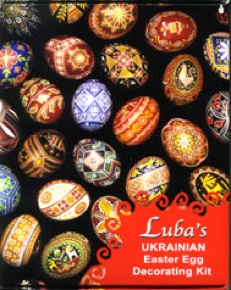
Ukrainian EggCessories also have a series of kits, and include their own booklet “Pysanka Party” as well as their own wooden-handled stylus, beeswax, and a cleaning wire. The kits have names like “Eggcitement Starts Here” (student kit), “The More The Merrier (Family & Friends Pysanky Kit)” and “Spread the Joy” (for Pysanky teachers).
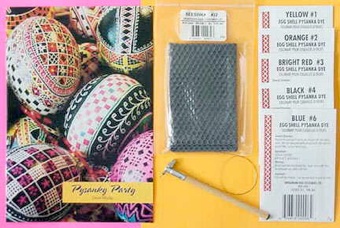
Wax Art Supply has recently (2010) begun selling their products in kit form. They have kits which contain various combinations of electric or traditional styluses, waxes, and dyes, along with their own instruction sheets, in a compartmentalized plastic case. Wax Arts’ products are generally high quality, and so are the kits, including the sturdy plastic boxes they come in.
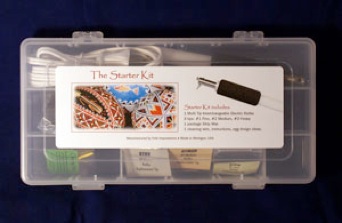
There are probably many other kits out there, but these are the only ones I feel qualified to comment on. As always, shop around–some kits are much better value than others.
Links:
TRADITIONAL STYLUSES
All pysanka suppliers carry traditional (non-electric) styluses, and most will offer a variety. The wooden handled ones are good for beginners, but, if you want better results, the Delrin and “almost electric” styles (plastic handled) have larger reservoirs, seem to drip less and don’t catch on fire as easily3. The EggCessories stylus is a bit of a hybrid, with a wooden handle but electric-styled reservoir and tip. The top of the stylus is metal, also preventing the problem of burning.
Drop-pull styluses are less common, but Wax Art Supply carries two different models, with wooden and plastic handles, and has recently released a line of their own, much nicer, brass tipped styluses.
Links:
ELECTRIC STYLUSES
For electric styluses, there are many sources. I have bought several types.
The standard “White” (and sometimes referred to as “Green”) electric stylus has been around forever, and I have a lot of them. It was the first commercially produced electric stylus, introduced in the early 1970s, and most of the styluses are still in use–they rarely wear out or break down. Each has a finer tip for a given size than Larry’s, and the metal is harder (nickel-plated brass), so it doesn’t wear out as quickly. They are made by a small family company in Michigan (Wax Art Supply), but sold by many pysanka suppliers. In 2008 they updated their line by adding black foam padding to the handle. This allows a cooler grip, and it a much appreciated improvement. There are both fixed tip versions and an interchangeable tip version available. They are sold directly by Wax Art Supply, and by the Polish Art Center, as well as other retailers. These are the styluses that used to be carried by UGS, and were often referred to as “UGS styluses” (before UGS decided to start their own line of cork-handled electric styluses).
Larry’s electric kistka has a softer brass tip, and a more comfortable cork handle. Larry has retired, and the UGS produced these electric styluses for a while, but have since discontinued them. I find the heads to be a bit short, but that is a personal quibble. I like using the medium size for making traditional pysanky, and also for coloring in small areas. You might sometimes find Larry’s styluses for sale on eBay, but, as noted, they have been phased out.
In 2009 UGS released an updated version of Larry’s styluses, and changed the name to “Luba’s” electric kistka. They changed the shape of the cork handle, and elongated the metal portion at the top of the stylus. This new version also uses a different, longer reservoir, which is not interchangeable with the previous versions (Larry’s), and which appears to be brass. The stylus allows these newer tips/reservoirs to be easily changed, using a small Allen wrench (supplied). I have difficulty using this type of stylus, as the elongated head interferes with my line of site. Other pysankarky use it and love it, so YMMV.
Ukrainian Egg-Cessories of Ontario makes its own electric styluses based on the original design by Michael Olynyk; they have a hard stainless-steel tip, a foam-covered cushioned handle and new black handle. The styluses are light and easy to use, and the wax reservoir is quite large, a plus in my book. These styluses are available only through EggCessories and a few stores and museums.
I personally own at least 13 different electric styluses, as mixing the various types gives me a larger palette of line widths to work with.
Most retailers sell the traditional “white” Wax Art styluses. Many retailers sold Larry’s styluses, and will probably sell Luba’s as well. The Eggcessories styluses are most readily available through their site.
Links:
STYLUS HOLDERS:
UGS produces, and many retailers sell, well constructed, sturdy metal stylus holders. There are 1 and 3 kistka models, as well as different models for traditional and electric styluses.
Robert Terry, of RJT Designs, produced custom made wooden stylus holders, but they no longer appears on his Etsy page. These holders were for any number (up to 10) of styluses, and included a clever drip catcher (see below) and plastic clips to hold the cords in place. His standard designs were for 1 to 10 styluses, but, if you have as many as I do, you could custom order even longer ones. Since each holder is individually made, you can choose the color of the wood (I am partial to Minwax cherry) and whether you prefer a high rise (pictured) or low rise version. I don’t know if he still produces these, but you ocudl visit his Etsy page and ask.....
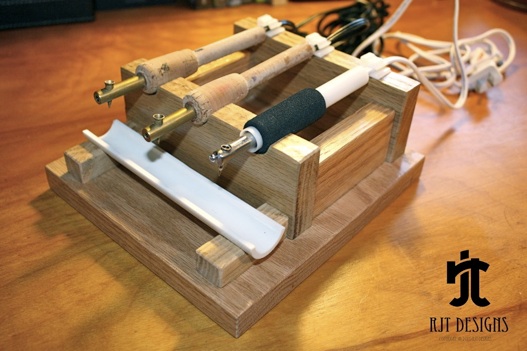
Ukrainian EggCessories has developed several new stylus holders: one is somewhat like Rob Terry’s model (wood and plastic clips, below), while others are plastic and metal. You can view the full range of their offerings on their site.

Links:
DYES:
There are many, many colors of aniline dyes available commercially in North America. The five commercial suppliers of such dyes packaged specifically for use in making pysanky that I have had experience with are UGS, Surma (New York, NY), Egg-Cessories , Pysanky Showcase, and Wax Art Supply.
The first three have many of the same names for their dyes, but the actual colors can vary a lot. The reds are a good example: UGS's scarlet (formerly bright red) is quite orangey, as opposed to the Eggcessories bright red, which is a full, darker red. The same is true for many of the other colors––there is much variation, as all are custom blends. It is worth trying them out to see which you particular brands you like for which colors.
How many colors does each brand have?
-
•UGS: 17 different colors
-
•EggCessories: 20 different colors
-
•Pysanky Showcase: 38 different colors
-
•Wax Art Supply: 36 different colors (...and counting)
The Pysanky Showcase dyes have a much greater spectrum, including several "brilliant" shades among the 38 offered, while the colors of the other brands are generally closer to traditional pysanka colors.
Are 104 colors of pysanka dye not enough for you? You can also try out commercial silk and wool dyes to color your pysanky. I have been using some Ukrainian dyes meant for wool; I use about half an actual teaspoon of dye to 1.5 cups boiling water, and add 1-2 tablespoons of white vinegar. Others make the dyes stronger4. I’ve had good luck with all but the yellow and green so far.
A North American source for such dyes (and there are many) is the Dharma trading company, which sells Jacquard dyes and its own brand as well. If purchasing such dyes, make sure you order the acid dyes meant for wool, nylon and silk (all are proteinaceous fibers). Do NOT order the dyes meant for cotton. Mix them up5 as I noted above.
Links:
BEESWAX
Most pysanka equipment suppliers will also supply beeswax, in various forms and shades. If using traditional styluses, regular cakes of wax are all you need. Spaghetti/strip wax is useful if using the Delrin or “Almost Electric” type of traditional stylus, but not absolutely necessary.
If using electric styluses, you will need darkened beeswax. I prefer the darkened spaghetti/strip wax, which I cut up into small segment for easier use, although in recent years I have been making my own darkened wax by adding candle wax colorant to molten beeswax..
The newer very fine electric styluses (XF, XXF, etc.) will not work well with ordinary wax, whether darkened or not. They need ultra-filtered waxes, similar to jewelry waxes. Wax Art Supply carries several types of ultra-filtered beeswax, as well as ordinary darkened spaghetti/strip wax.
If you want large quantities, or need any beeswax candles, a good source is the Beeswax Candle Works. They not only sell blocks of wax in various sizes for making pysanky (natural, not darkened), but have small candles available that are good for making krapanky.
If you have people in your area making and selling honey, it might be worthwhile to contact them about buying wax. You could get it in bulk, and make your own smaller cakes (silicon muffin tins are perfect for this).
Another possible source of free wax (besides beekeeper friends) is churches. Orthodox and Catholic churches still have lots of candles lit by faithful parishioners. Many churches use paraffin candles because they are much cheaper, but some still use beeswax ones. The beeswax candles burn longer, produce much less soot, and smell much nicer. The candles are usually snuffed before they burn out completely, and often discarded. The starosty at our church now save them for me and a few others––I take them home, melt them down, and make beeswax cakes (in my case, for pysanka classes), as well as using the candles themselves to remove wax from pysanky.
Links:
POSTCARDS
Pysanka postcards used to be quite common, but are harder to find now.
UGS still sells postcards in their shop, and include them in several of their kits, but do not offer them in their catalog or on their web site. If you happen to be in Minneapolis, you can go have a look, but otherwise you’re out of luck.
And sometimes antique cards might show up on eBay, but that’s about it.
Links:
DESIGN SHEETS
Many pysanka retailers offer design sheets (step-by-step and other). These are usually included in pysanka kits, but are sometimes sold separately as well. Such sheets can be useful for beginners or even more experienced pysanka makers.
The UGS books all have several pages of step-by-step designs, and the Design Books (1-5) have very good, detailed sets of designs, which go through each pattern in a meticulous manner, starting with how to draw the pencil lines, and showing dye sequences and waxing.
I have two sets of patterns available for free download on my site, here and here.
Links:
EGGS:
I’ve never bought eggs on line, as I stick to chicken eggs, and prefer using full eggs. Many pysanka makers like to use more exotic eggs, like goose, duck, ostrich, emu or turkey. They often buy them on line.
Bracken Ridge has come highly recommended. Others have bought on eBay, but you’re never sure what you’re getting. Eggs can arrive badly packed and broken into pieces, or with huge holes where they’ve been emptied. Also, not all egg suppliers are used to dealing with pysanka makers, and may treat the eggs with chemicals that ruin the cuticle or scratch up the surface, making them useless for making pysanky.
Craigslist can help you find a local supplier of fresh eggs. I found a good source of goose eggs this way, and will soon have fresh chicken eggs, too. Simply go to Craigslist, enter your location and what you’re searching for. You should get a list of possibilities, which you can then narrow down. Remember to let the seller know that you need eggs which have not been treated in any fashion, except perhaps rinsing in water. Some sellers oil eggs to help preserve them, others will wash them with harsh detergents.
Links:
OTHER
Templates, findings, craft lathes and egg blowers can be found at many pysanka supply retailers. Lathes can also sometimes be found at local craft stores like Michaels.
Similarly, many retailers sell egg stands.
This page at Wikianswers is worth having a look at, too.
Links:
Remember: when ordering supplies (or anything, really) on line, the same item can vary greatly in price from site to site. It is often cheapest to buy from the actual producer of the product. Shipping costs can also be quite high, especially if ordering from another country. Always compare prices among several shops (including shipping costs and taxes) before making your final purchase!
__________
-
1.Non-specialty items are the sorts of things you can buy almost anywhere in ordinary stores: paper towels, vinegar, spoon, candles, etc.
-
2.I purchase many of my eggs from an Amish poultry shop. I find I get much better results, as the eggs have not been processed as much as the ones I can find at most grocery stores. An exception is Hamilton eggs, a local Michigan brand that takes dye well.
Sadly, many of the organic eggs come with inked “brand” stamps that are almost impossible to remove. A happy exception is Trader Joe’s, which sells both white and brown organic eggs at a very reasonable price, and in cardboard egg cartons. -
3.You really have to try. I’ve seen the plastic scorched and melted a bit, and I’ve seen the wax catch fire, but both are rare events and require significant negligence. The wooden ones, being wooden, can catch fire easily; after a few burns, the cone can become quite loose and the stylus hard to use.
-
4.On the Dharma site they include a recipe for mixing up dyes for pysanka provided by one of their customers. She uses Jacquard Acid Dyes, “mixing 1 teaspoon of powder dye (or more if you want a deeper more intense color), 1 cup boiling water, and 1-2 tablespoons of white vinegar. Let the dye cool before use.”
-
5.This is my guess as to the amount needed, and this may be more–or less–concentrated than necessary. Markian at Surma told me the ladies who packaged their dyes just “eyeball “ the amount, so he’s not sure of the exact measurement, although he thought it was less than half a teaspoon per packet.
I purchased a bunch of Dharma dyes, and will let you know how they turn out. I also purchased a few natural dyes, including indigo, cochineal and brazilwood; the cochineal is now in Ukraine, where my friend Vira wants to try them out.
Back to MAIN Pysanka home page.
Back to Main Links home page.
Back to Pysanka Index.
Supplies
